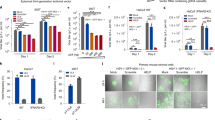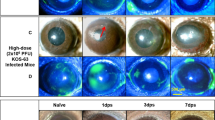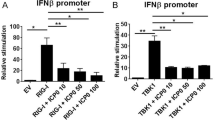Abstract
It has been widely believed that recurrence of herpes simplex keratitis (HSK) is due to the reactivation of herpes simplex virus type 1 (HSV-1) from latent sites in trigeminal ganglion (TG). However, there are also not effective vectors which could target TG for therapy. Replication-defective HSV-1 vector (rdHSV-IFNγ) was established by calcium phosphate co-transfection of complementing cells. We firstly infected rdHSV-IFNγ to SH-SY5Y, and detected IFNγ expression by western blot, evaluated 50 % cellular cytotoxicity (CC50) by ELISA. Antiviral activity of rdHSV-IFNγ was examined by immunofluorescence and antiviral concentration of 50 % effectiveness (EC50) assay. The rdHSV-IFNγ vector was immunized to Wistar rats to observe targeting function to TG. Kaplan–Meier survival analysis was utilized to assess security of rdHSV-IFNγ. RT-PCR and immunohistochemistry assay were employed to detect rdHSV-IFNγ localization in TG. Western blot was employed to detect IFNγ expression. rdHSV-IFNγ was successfully established, and performed an effective antiviral activity and higher security in SH-SY5Y. There were no significant differences of survival and corneal infection rate of rdHSV-IFNγ immunized rats among groups (P > 0.05). RT-PCR and immunohistochemistry indicated that expression of glycoprotein D (gD) in TG could target TG and decreased following with times post immunization. Furthermore, IFNγ was expressed effectively in TG tissues. Our findings indicated that established rdHSV-IFNγ vector effectively transported therapeutic gene into TG tissues. The administration of replication-defective vector carrying therapeutic genes may become a promising tool in inhibition or reoccurrence of HSK in clinical.






Similar content being viewed by others
References
Anesti AM, Peeters PJ, Royaux I, Coffin RS (2008) Efficient delivery of RNA interference to peripheral neurons in vivo using herpes simplex virus. Nucleic Acids Res 36(14):e86
Arefian E, Bamdad T, Soleimanjahi H, Akhood MR, Parsania M, Ghaemi A (2009) A kinetic study of gamma interferon production in herpes simplex virus-1 DNA prime-protein boost regimen comparing to DNA or subunit vaccination. Mol Biol (Mosk) 43(3):388–393
Awasthi S, Lubinski JM, Friedman HM (2009) Immunization with HSV-1 glycoprotein C prevent immune evasion from complement and enhances the efficacy of an HSV-1 glycoprotein D subunit vaccine. Vaccine 27(49):6845–6853
Bryant-Hudson K, Conrady CD, Carr DJJ (2013) Type I interferon and lymphangiogenesis in the HSV-1 infected cornea, are they beneficial to the host? Prog Retin Eye Res 36(1):281–291
Chen D, Zhang D, Xu L, Han Y, Wang H (2013) The alterations of matrix metalloproteinase-9 in mouse brainstem during herpes simplex virus type 1-induced facial palsy. J Mol Neurosci 51(3):703–709
Chiang LC, Chiang W, Chang MY, Ng LT, Lin CC (2002) Antiviral activity of Plantago major extracts and related compounds in vitro. Antivir Res 55(1):53–62
Dong-Newsom P, Powell ND, Bailey MT, Padgett DA, Sheridan JF (2010) Repeated social stress enhances the innate immune response to a primary HSV-1 infection in the cornea and trigeminal ganglia of Blab/C mice. Brain Behav Immu 24(2):273–280
Farooq AV, Shukla D (2012) Herpes simplex epithelial and stromal keratitis: an epidemiologic update. Surv Ophthalmol 57(5):448–462
Geller AI, Freese A (1990) Infection of cultured central nervous system neurons with a defective herpes simplex virus 1 vector results in stable expression of Escherichia coli beta-galactosidase. Proc Natl Acad Sci U S A 87:1149–1153
Goel N, Rong Q, Zimmerman D, Rosenthal KS (2003) ALEAPS heteroconjugate vaccine containing a T cell epitope from HSV-1 glycoprotein D elicits Th1 responses and protection. Vaccine 21(27–30):4410–4420
Goins WF, Cohen JB, Glorioso JC (2012) Gene therapy for the treatment of chronic peripheral nervous system pain. Neurobiol Dis 48(2):255–270
Hu K, Dou J, Yu F, He X, Yuan X, Wang Y, Liu C, Gu N (2011) An ocular mucosal administration of nanoparticles containing DNA vaccine Prsc-Gd-IL-21 confers protection against mucosal challenge with herpes simplex virus type 1 in mice. Vaccine 29(7):1455–1462
Jiang Y, Wei N, Zhu J, Zhai D, Wu L, Chen M, Xu G, Liu X (2012) A new approach with less damage: intranasal delivery of tetracycline-inducible replication-defective herpes simplex virus type-1 vector to brain. Neuroscience 201(1):96–104
Kaye S, Choudhary A (2006) Herpes simplex keratitis. Prog Retin Eye Res 25(4):355–380
Liesegang J (2001) Herpes simplex virus epidemiology and ocular importance. Cornea 20(1):1–3
Lilley CE, Groutsi F, Han Z, Palmer JA, Andersoon PN, Latchman DS, Coffin RS (2001) Multiple immediate-early gene-deficient herpes simplex virus vectors allowing efficient gene delivery to neurons in culture and widespread gene delivery to the central nervous system in vivo. J Virol 75(9):4343–4356
Loffler T, Flunkert S, Taub N, Schofield EL, Ward MA, Windisch M, Hutter-Paier B (2012) Stable mutated tau441 transfected SH-SY5Y cells as screening tool for Alzheimer’s disease drug candidates. J Mol Neurosci 47(1):192–203
Palmer JA, Branston RH, Lilley CE, Robinson MJ, Groutsi F, Smith J, Latchman DS, Coffin RS (2000) Development and optimization of herpes simplex virus vectors for multiple long-term gene delivery to the peripheral nervous system. J Virol 74:5604–5618
Quenelle DC, Collins DJ, Rice TL, Prichard MN, Marciani DJ, Kern ER (2008) Effect of an immune enhancer, GPI-100, on vaccination with live attenuated herpes simplex virus type 2 or glycoprotein D on genitial HSV-2 infections of guinea pigs. Antiviral Res 80(2):223–224
Rasty S, Thatikunta P, Gordon J, Khalili K, Amini S (1996) Human immunodeficiency virus tat gene transfer to the murine central nervous system using a replication-defective herpes simplex virus vector stimulates transforming growth factor beta 1 gene expression. Proc Natl Acad Sci U S A 93:6073–6078
Sheppard JD, Wertheimer ML, Scoper SV (2009) Modalities to decrease stromal herpes simplex keratitis reactivation rates. Arch Ophthalmol 127(7):852–856
Theopold CP, Gheerardyn R, Bleiziffer O, Velander PE, Yao F, Eriksson E (2004) A novel replication-defective HSV-1 vector for regulatable gene delivery to wounds. J Am Coll Surg 199(3):57–58
van Lint AL, Torres-Lopez E, Knipe DM (2007) Immunization with a replication-defective herpes simplex virus 2 mutant reduces herpes simplex virus 1 infection and prevents ocular disease. Virology 368(2):227–231
Whitehead JL, Ohara PT, Tauscher AN, LaVail JH (2003) A procedure to deliver simplex virus to the murine trigeminal ganglion. Brain Res Protocol 12(1):60–66
Xu K, Wang X, Shi Q, Chen C, Tian C, Li XL, Zhou RM, Chu YL, Dong XP (2011) Human prion protein mutants with deleted and inserted. Octarepeats undergo different pathways to trigger cell apoptosis. J Mol Neurosci 43(3):225–234
Acknowledgements
This research was supported by Science and Technology Research and Development Program of Shaanxi Province of China (Grant No. 2011 K12-55).
Conflicts of interest
We declare that we have no conflict of interest.
Author information
Authors and Affiliations
Corresponding author
Rights and permissions
About this article
Cite this article
Xu, K., Liu, XN., Zhang, HB. et al. Replication-Defective HSV-1 Effectively Targets Trigeminal Ganglion and Inhibits Viral Pathopoiesis by Mediating Interferon Gamma Expression in SH-SY5Y Cells. J Mol Neurosci 53, 78–86 (2014). https://doi.org/10.1007/s12031-013-0199-x
Received:
Accepted:
Published:
Issue Date:
DOI: https://doi.org/10.1007/s12031-013-0199-x




